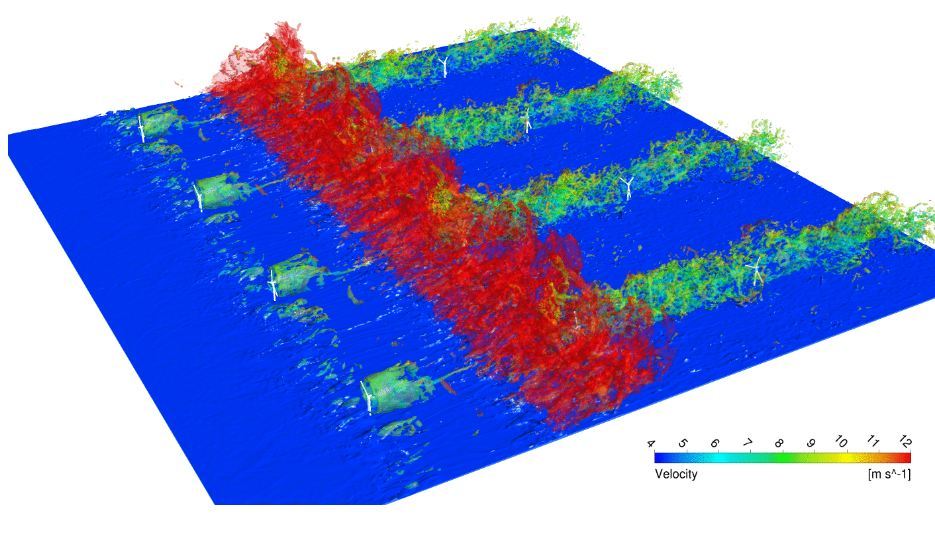
Putting turbulence to work
John Cater, Department of Engineering Science
Optimising the new generation of wind turbines
In this simulation, each turbine operates individually and responds to the increased speed by changing its blade rotation speed and pitch angle. Although the gust starts out a large coherent structure (at the left-hand side of the picture), it is broken up by the presence of the front row of turbines and turbulent wakes are generated, which produce a very ‘messy’ flow at subsequent turbines. These messy wakes are responsible for high fluctuating loads on the turbine shafts. This work is world-leading, and has led to a number of recent high-profile publications. Other projects using the computing facilities of the NeSI Pan cluster include simulating the flow through the human upper airway, where turbulence is important in the mixing of gases, such as CO2 during the breathing cycle, and in the generation of some parts of speech (called fricatives).

Simulating turbulent flows
The Pan cluster at the University of Auckland is used for a wide range of turbulent flow problems to generate statistically significant data sets to better model momentum and energy transport. These simulations produce enormous file sizes that are too large to be processed on desktop computers (more than 30GB per timestep, and hundreds of timesteps are needed). The large memory and storage capacity of Pan made these simulations possible. The turbulent flow data generated to date has been used to improve the efficiency of offshore wind farms, to create more sophisticated breathing support devices and to improve our understanding of sound production. The computational fluid dynamics (CFD) software called ANSYS with CFX is used for the simulations.
The next projects that will use Pan will be focussed on using turbulent flows to improve the productivity of the primary industries sector in NZ. Dr Cater’s group will use the parallel computing facilities on the Pan cluster to model the complex mechanics of the bovine rumen and to study the discharge of effluent in marine aquaculture such as that from mussel farms and fish cages.
See more case study projects

Our Voices: using innovative techniques to collect, analyse and amplify the lived experiences of young people in Aotearoa

Painting the brain: multiplexed tissue labelling of human brain tissue to facilitate discoveries in neuroanatomy

Detecting anomalous matches in professional sports: a novel approach using advanced anomaly detection techniques

Benefits of linking routine medical records to the GUiNZ longitudinal birth cohort: Childhood injury predictors

Using a virtual machine-based machine learning algorithm to obtain comprehensive behavioural information in an in vivo Alzheimer’s disease model

Mapping livability: the “15-minute city” concept for car-dependent districts in Auckland, New Zealand

Travelling Heads – Measuring Reproducibility and Repeatability of Magnetic Resonance Imaging in Dementia

Novel Subject-Specific Method of Visualising Group Differences from Multiple DTI Metrics without Averaging

Re-assess urban spaces under COVID-19 impact: sensing Auckland social ‘hotspots’ with mobile location data

Aotearoa New Zealand’s changing coastline – Resilience to Nature’s Challenges (National Science Challenge)

Proteins under a computational microscope: designing in-silico strategies to understand and develop molecular functionalities in Life Sciences and Engineering

Coastal image classification and nalysis based on convolutional neural betworks and pattern recognition

Determinants of translation efficiency in the evolutionarily-divergent protist Trichomonas vaginalis

Measuring impact of entrepreneurship activities on students’ mindset, capabilities and entrepreneurial intentions

Using Zebra Finch data and deep learning classification to identify individual bird calls from audio recordings

Automated measurement of intracranial cerebrospinal fluid volume and outcome after endovascular thrombectomy for ischemic stroke

Using simple models to explore complex dynamics: A case study of macomona liliana (wedge-shell) and nutrient variations

Fully coupled thermo-hydro-mechanical modelling of permeability enhancement by the finite element method

Modelling dual reflux pressure swing adsorption (DR-PSA) units for gas separation in natural gas processing

Molecular phylogenetics uses genetic data to reconstruct the evolutionary history of individuals, populations or species

Wandering around the molecular landscape: embracing virtual reality as a research showcasing outreach and teaching tool
























































































































































